托福阅读背景知识
- 格式:doc
- 大小:477.50 KB
- 文档页数:95
![[了解托福阅读背景知识把握各类题型是关键]](https://uimg.taocdn.com/02cdf21ffbd6195f312b3169a45177232f60e46e.webp)
[了解托福阅读背景知识把握各类题型是关键]托福阅读提升有技巧了解背景知识把握各类题型是关键托福阅读技巧一了解背景知识更易读懂文章有部分学生反映做阅读时很难投入进去,有一点原因就是对于文章所述内容太过陌生,如果你对其略知一二,相信定会有所不同。
比如官方真题Official中有篇文章讲到化学元素周期表,对于高中生来说再熟悉不过了,阅读的时候半读半猜,估计也可以理解的八九不离十了。
若考试准备时间充足,可以多加涉猎,扩充自己的知识背景;若时间紧张,则需搞定官方真题Official套题。
根据文章记忆单词,并不是文章中出现的每一个“陌生的面孔”都要去熟悉,比如一些繁琐的专有名词跳过即可。
主要记忆的当然是一些动词、名词及形容词,尤其是出现在句子主干中,与解题有关的词汇。
除了词汇,应学会分析题干及题目,比如题干中出现了effect,conclusion之类的词,其实已经界定了我们寻找的范围——段落靠后的部分,还有就是观点性和总结性的句子永远会是考察的重点所在。
做题的时候学会分析原文和选项,进行对比,比如句子简化题,做一题需要看五个长句,似乎很花费时间,但并不需要每个句子都要细看,而是先明确原句的逻辑及主干,抓住选项中的关键点与原句进行比较。
例如:As a result of crustal adjustments and faulting, the Strait ofGibraltar, where the Mediterranean now connects to the Atlantic, opened, andwater cascaded spectacularly back into the Mediterranean.A.The strait ofGibraltar reopened when the Mediterranean and the Atlantic became connected andthe cascades of water from one sea to the other caused crustal adjustments andfaulting.B. The Mediterranean was dramatically refilled by water from theAtlantic when crustal adjustments and faulting opened the Strait of Gibraltar,the place where the two seas are joined.C. The cascades of water from theAtlantic to the Mediterranean were not as spectacular as the crustal adjustmentsand faulting that occurred when the Strait of Gibraltar was connected to thoseseas.D. As a result of crustal adjustments and faultin;g and the creation of theStrait of Gibraltar, the Atlantic and Mediterranean were connected and became asingle sea with spectacular cascades of water between them。

新托福阅读背景知识最新整合新托福阅读背景知识:伟大的民主诗人怠特曼伟大的民主诗人怠特曼美国19世纪的民主精神在惠特曼的《草叶集》(1855)里得到充分发挥。
他以丰富、博大、包罗万象的气魄反映了广大劳动群众在民主革命时期的乐观向上精神。
他歌颂劳动,歌颂大自然,歌颂物质文明,歌颂“个人”的理想形象;他的歌颂渗透着对人类的广泛的爱。
诗人以豪迈、粗犷的气概蔑视蓄奴制和一切不符合自由民主理想的社会现象。
他那种奔放的自由诗体,同他的思想内容一样,也是文学史上的创新,产生了广泛的影响。
新托福阅读背景知识:钟乳石的形成关于钟乳石的形成石灰岩洞中的钟乳石、石笋是怎样形成的桂林是世界闻名的风景区,山奇水秀,风景美丽,因此自古就有“桂林山水甲天下”之称。
桂林除山水美之外,还有更具特色的石灰岩洞,七星岩是比较有代表性的溶洞。
洞内到处悬垂着美丽的钟乳石,有的像累累的果实,有的像盛开的花朵。
与之相对应的石笋拔地而起,一个个像春天从地面下“冒”出来的竹笋。
那么这些奇丽的钟乳石和石笋是怎样形成的呢?原来“盛产”钟乳石和石笋的溶洞都是石灰岩构成的。
洞顶有很多的裂隙,每一处裂隙里都有水滴渗透出来。
每当水分蒸发掉后,那里就会留下一些石灰质的沉淀,日积月累,天长日久洞顶上的石灰质愈积愈多,终于形成了乳头。
以后,乳头外面又包起一层石灰质,以至越垂越长,就形成了姿态万千的钟乳石。
石笋其实就是钟乳石的孪生兄弟。
当洞顶上的水滴落下来时,石灰质也在地面上沉积起来,就这样石笋对着钟乳石向上长起来,若是说钟乳石是“兄长”,那石笋就是“孪生弟弟”了。
而石笋底盘大,本身比较稳定不易折断,所以它比钟乳石的生长速度还要快,还要粗壮呢。
新托福阅读背景知识:美国文学简史美国文学(American Literature)美国文学的历史不长,它几乎是和美国自由资本主义同时出现,较少受到封建贵族文化的束缚。
美国早期人口稀少,有大片未开发的土地,为个人理想的实现提供了很大的可能性。
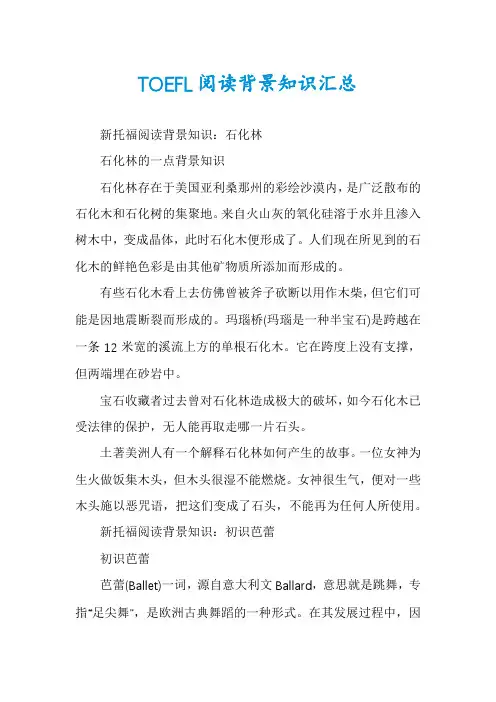
TOEFL阅读背景知识汇总新托福阅读背景知识:石化林石化林的一点背景知识石化林存在于美国亚利桑那州的彩绘沙漠内,是广泛散布的石化木和石化树的集聚地。
来自火山灰的氧化硅溶于水并且渗入树木中,变成晶体,此时石化木便形成了。
人们现在所见到的石化木的鲜艳色彩是由其他矿物质所添加而形成的。
有些石化木看上去仿佛曾被斧子砍断以用作木柴,但它们可能是因地震断裂而形成的。
玛瑙桥(玛瑙是一种半宝石)是跨越在一条12米宽的溪流上方的单根石化木。
它在跨度上没有支撑,但两端埋在砂岩中。
宝石收藏者过去曾对石化林造成极大的破坏,如今石化木已受法律的保护,无人能再取走哪一片石头。
土著美洲人有一个解释石化林如何产生的故事。
一位女神为生火做饭集木头,但木头很湿不能燃烧。
女神很生气,便对一些木头施以恶咒语,把这们变成了石头,不能再为任何人所使用。
新托福阅读背景知识:初识芭蕾初识芭蕾芭蕾(Ballet)一词,源自意大利文Ballard,意思就是跳舞,专指“足尖舞”,是欧洲古典舞蹈的一种形式。
在其发展过程中,因常以这种舞蹈来叙述表演故事,而逐渐形成了一种特殊的演出形式。
1772年,查理·狄德罗(Charles Diderot)在法国大百科全书中说:“芭蕾系用跳舞解释行动。
特别要求剧场性的赏心悦目。
”。
帕鲁金尼(Perugino)更详细地叙述说:“芭蕾是由一位编导,运用连带哑剧的一系列独舞和群众,附加音乐和布景,去表现一种诗情画意,或一连串概念,或一个故事化的情节。
”芭蕾这种舞蹈形式一直发展到今天,形成了完整的舞剧艺术。
对于中国观众来说,芭蕾并不陌生,尤其近些年来,芭蕾受到了越来越多的观注,一股“芭蕾热”已经在几座大城市悄然兴起。
1997年的“中国歌剧舞剧年”可以说是热闹非凡,各个中外演出团体为广大观众献上了一台又一台精彩的演出,真是“你方唱罢我登场”。
从通俗的《天鹅湖》到浪漫的《吉赛尔》,从“拉丁味”的《堂·吉诃德》到充满海新托福阅读背景知识:脚尖的艺术脚尖的艺术从运动的实际需要来看,脚尖鞋的发明能够将舞者身体的重量支撑“面”经过若干倍的缩小后变成支撑“点”,从而有效地减小与地面的摩擦力,提高旋转的速度,造成风驰电掣的效果、超凡脱俗的幻觉,进而更好地为仙凡之恋这类虚幻的芭蕾题材服务。
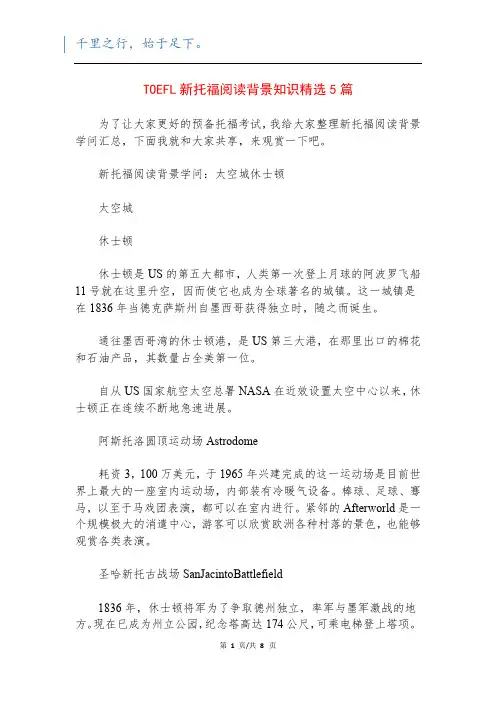
TOEFL新托福阅读背景知识精选5篇为了让大家更好的预备托福考试,我给大家整理新托福阅读背景学问汇总,下面我就和大家共享,来观赏一下吧。
新托福阅读背景学问:太空城休士顿太空城休士顿休士顿是US的第五大都市,人类第一次登上月球的阿波罗飞船11号就在这里升空,因而使它也成为全球著名的城镇。
这一城镇是在1836年当德克萨斯州自墨西哥获得独立时,随之而诞生。
通往墨西哥湾的休士顿港,是US第三大港,在那里出口的棉花和石油产品,其数量占全美第一位。
自从US国家航空太空总署NASA在近效设置太空中心以来,休士顿正在连续不断地急速进展。
阿斯托洛圆顶运动场Astrodome耗资3,100万美元,于1965年兴建完成的这一运动场是目前世界上最大的一座室内运动场,内部装有冷暖气设备。
棒球、足球、骞马,以至于马戏团表演,都可以在室内进行。
紧邻的Afterworld是一个规模极大的消遣中心,游客可以欣赏欧洲各种村落的景色,也能够观赏各类表演。
圣哈新托古战场SanJacintoBattlefield1836年,休士顿将军为了争取德州独立,率军与墨军激战的地方。
现在已成为州立公园,纪念塔高达174公尺,可乘电梯登上塔项。
塔下是历史博物馆。
距休士顿市约26公里。
US航空太空总署太空飞行中心NASAMannedSpacecraft因阿波罗11号在此升空而全球著名。
US国家航空太空总署NASA于1961年设立于休士顿东南方45公里处的克利阿湖畔。
四周有GeneralElectric和InternationalBusinessMachines等重要的电子工业企业,是名符其实的航空太空科学中心。
展览馆Exhibit Hall的一号馆中,陈设着太空飞行员使用的器具、太空食物、太空船模型、月球上采集的岩石,对一般观光客公开。
太空飞行中心内部极为宽阔,可在进入中心的问讯处索取地图,备作参考。
太空中心内也有礼品店,出售太空船模型、月球石头模型,以及阿波罗帽等。
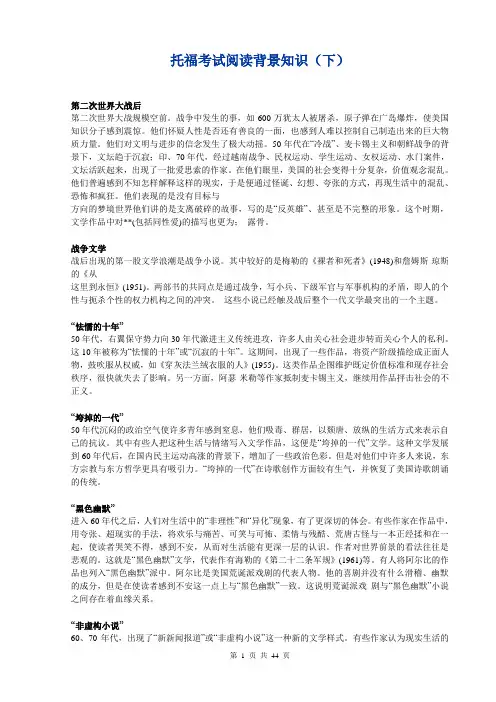
托福考试阅读背景知识(下)第二次世界大战后第二次世界大战规模空前。
战争中发生的事,如600万犹太人被屠杀,原子弹在广岛爆炸,使美国知识分子感到震惊。
他们怀疑人性是否还有善良的一面,也感到人难以控制自己制造出来的巨大物质力量。
他们对文明与进步的信念发生了极大动摇。
50年代在“冷战”、麦卡锡主义和朝鲜战争的背景下,文坛趋于沉寂;印、70年代,经过越南战争、民权运动、学生运动、女权运动、水门案件,文坛活跃起来,出现了一批爱思索的作家。
在他们眼里,美国的社会变得十分复杂,价值观念混乱。
他们普遍感到不知怎样解释这样的现实,于是便通过怪诞、幻想、夸张的方式,再现生活中的混乱、恐怖和疯狂。
他们表现的是没有目标与方向的梦境世界他们讲的是支离破碎的故事,写的是“反英雄”、甚至是不完整的形象。
这个时期,文学作品中对**(包括同性爱)的描写也更为;露骨。
战争文学战后出现的第一股文学浪潮是战争小说。
其中较好的是梅勒的《裸者和死者》(1948)和詹姆斯·琼斯的《从这里到永恒》(1951)。
两部书的共同点是通过战争,写小兵、下级军官与军事机构的矛盾,即人的个性与扼杀个性的权力机构之间的冲突。
这些小说已经触及战后整个一代文学最突出的一个主题。
“怯懦的十年”50年代,右翼保守势力向30年代激进主义传统进攻,许多人由关心社会进步转而关心个人的私利。
这10年被称为“怯懦的十年”或“沉寂的十年”。
这期间,出现了一些作品,将资产阶级描绘成正面人物,鼓吹服从权威,如《穿灰法兰绒衣服的人》(1955)。
这类作品企图维护既定价值标准和现存社会秩序,很快就失去了影响。
另一方面,阿瑟·米勒等作家抵制麦卡锡主义,继续用作品抨击社会的不正义。
“垮掉的一代”50年代沉闷的政治空气使许多青年感到窒息,他们吸毒、群居,以颓唐、放纵的生活方式来表示自己的抗议。
其中有些人把这种生活与情绪写入文学作品,这便是“垮掉的一代”文学。
这种文学发展到60年代后,在国内民主运动高涨的背景下,增加了一些政治色彩。
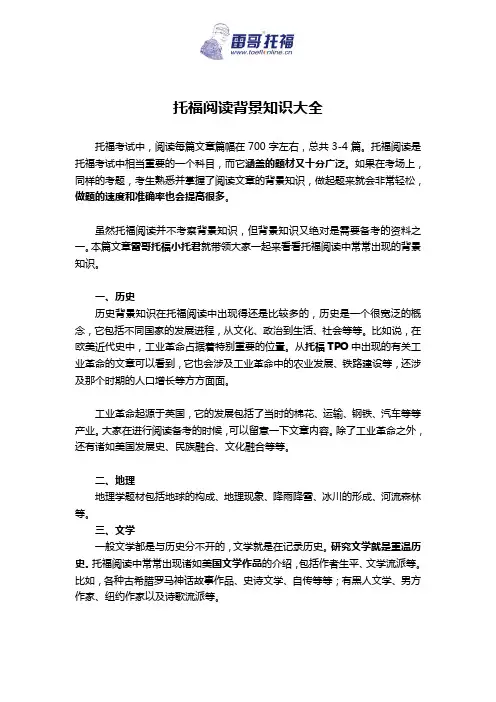
托福阅读背景知识大全托福考试中,阅读每篇文章篇幅在700字左右,总共3-4篇。
托福阅读是托福考试中相当重要的一个科目,而它涵盖的题材又十分广泛。
如果在考场上,同样的考题,考生熟悉并掌握了阅读文章的背景知识,做起题来就会非常轻松,做题的速度和准确率也会提高很多。
虽然托福阅读并不考察背景知识,但背景知识又绝对是需要备考的资料之一。
本篇文章雷哥托福小托君就带领大家一起来看看托福阅读中常常出现的背景知识。
一、历史历史背景知识在托福阅读中出现得还是比较多的,历史是一个很宽泛的概念,它包括不同国家的发展进程,从文化、政治到生活、社会等等。
比如说,在欧美近代史中,工业革命占据着特别重要的位置。
从托福TPO中出现的有关工业革命的文章可以看到,它也会涉及工业革命中的农业发展、铁路建设等,还涉及那个时期的人口增长等方方面面。
工业革命起源于英国,它的发展包括了当时的棉花、运输、钢铁、汽车等等产业。
大家在进行阅读备考的时候,可以留意一下文章内容。
除了工业革命之外,还有诸如美国发展史、民族融合、文化融合等等。
二、地理地理学题材包括地球的构成、地理现象、降雨降雪、冰川的形成、河流森林等。
三、文学一般文学都是与历史分不开的,文学就是在记录历史。
研究文学就是重温历史。
托福阅读中常常出现诸如美国文学作品的介绍,包括作者生平、文学流派等。
比如,各种古希腊罗马神话故事作品、史诗文学、自传等等;有黑人文学、男方作家、纽约作家以及诗歌流派等。
四、天文学涉及宇宙、银河、八大行星、日食月食极光天文现象、火星上有水、雷电现象等。
五、社会社会生活中大家比较关心的问题以及比较有争议的问题等,比如说,男女平等、抑郁症的治疗、节日庆典、人际交往、社会群体、社交媒体、交通问题、教育问题、城市规划等等。
六、动植物此题材属于托福阅读必考题材。
涉及到的内容通常涵盖某种动物的起源、某地植物的起源、乌龟的习性、鹿群数量的变迁、植物与矿物等。
七、其他类包括艺术(陶器、瓷器、音乐、绘画、玻璃艺术、手工艺)、建筑、生物科技、经济金融等。
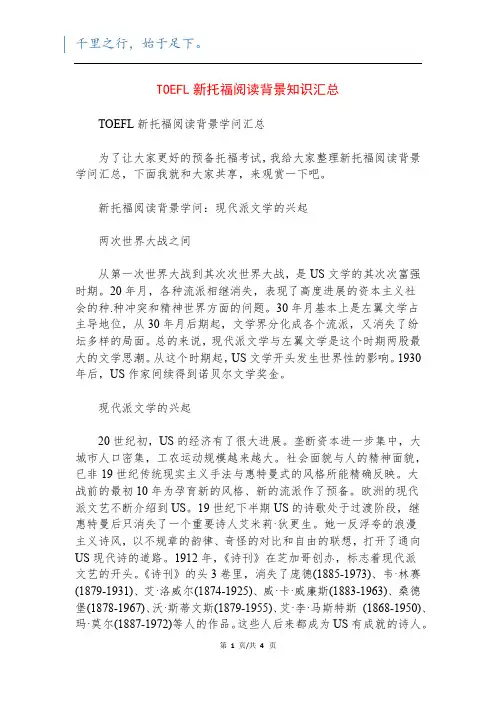
TOEFL新托福阅读背景知识汇总TOEFL新托福阅读背景学问汇总为了让大家更好的预备托福考试,我给大家整理新托福阅读背景学问汇总,下面我就和大家共享,来观赏一下吧。
新托福阅读背景学问:现代派文学的兴起两次世界大战之间从第一次世界大战到其次次世界大战,是US文学的其次次富强时期。
20年月,各种流派相继消失,表现了高度进展的资本主义社会的种.种冲突和精神世界方面的问题。
30年月基本上是左翼文学占主导地位,从30年月后期起,文学界分化成各个流派,又消失了纷坛多样的局面。
总的来说,现代派文学与左翼文学是这个时期两股最大的文学思潮。
从这个时期起,US文学开头发生世界性的影响。
1930年后,US作家间续得到诺贝尔文学奖金。
现代派文学的兴起20世纪初,US的经济有了很大进展。
垄断资本进一步集中,大城市人口密集,工农运动规模越来越大。
社会面貌与人的精神面貌,已非19世纪传统现实主义手法与惠特曼式的风格所能精确反映。
大战前的最初10年为孕育新的风格、新的流派作了预备。
欧洲的现代派文艺不断介绍到US。
19世纪下半期US的诗歌处于过渡阶段,继惠特曼后只消失了一个重要诗人艾米莉·狄更生。
她一反浮夸的浪漫主义诗风,以不规章的韵律、奇怪的对比和自由的联想,打开了通向US现代诗的道路。
1912年,《诗刊》在芝加哥创办,标志着现代派文艺的开头。
《诗刊》的头3卷里,消失了庞德(1885-1973)、韦·林赛(1879-1931)、艾·洛威尔(1874-1925)、威·卡·威廉斯(1883-1963)、桑德堡(1878-1967)、沃·斯蒂文斯(1879-1955)、艾·李·马斯特斯(1868-1950)、玛·莫尔(1887-1972)等人的作品。
这些人后来都成为US有成就的诗人。
其中有意象主义者,有接近劳动人民的芝加哥诗派,有20世纪的田园诗人,有新的乡土主义者,有抽象哲理派诗人。
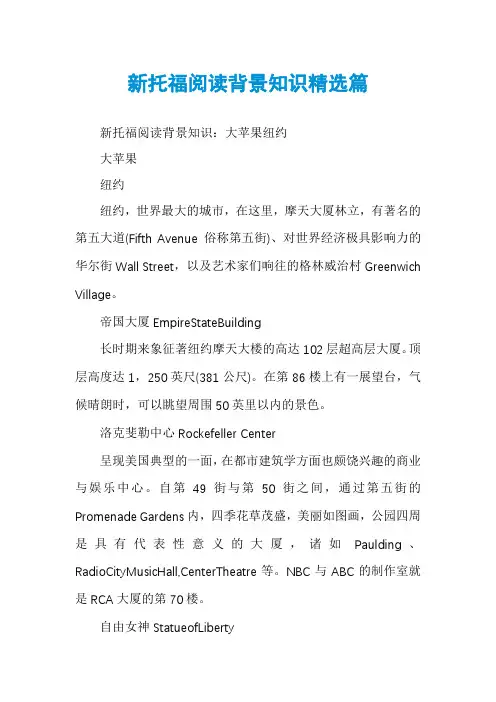
新托福阅读背景知识精选篇新托福阅读背景知识:大苹果纽约大苹果纽约纽约,世界最大的城市,在这里,摩天大厦林立,有著名的第五大道(Fifth Avenue俗称第五街)、对世界经济极具影响力的华尔街Wall Street,以及艺术家们响往的格林威治村Greenwich Village。
帝国大厦EmpireStateBuilding长时期来象征著纽约摩天大楼的高达102层超高层大厦。
顶层高度达1,250英尺(381公尺)。
在第86楼上有一展望台,气候晴朗时,可以眺望周围50英里以内的景色。
洛克斐勒中心Rockefeller Center呈现美国典型的一面,在都市建筑学方面也颇饶兴趣的商业与娱乐中心。
自第49街与第50街之间,通过第五街的Promenade Gardens内,四季花草茂盛,美丽如图画,公园四周是具有代表性意义的大厦,诸如Paulding、RadioCityMusicHall,CenterTheatre等。
NBC与ABC的制作室就是RCA大厦的第70楼。
自由女神StatueofLiberty世界著名的自由女神像,位于纽约湾的利勃坦岛上,像高约46公尺。
自由女神像内部中空,可搭电梯直达神像头部。
此外,还有新设的移民博物馆Immigration Museum。
联合国theUnitedNations纽约的历史系由曼顿产生,而现代世界史则与联合国密切相关。
自第42街起直到第48街上,在广达18英亩的地基上,就兴建着著名的联合国大厦。
联合国容许观光客依到达先后次序入内参观会议情形。
中国城Chinatown中国城已具有百年以上的历史,城内居住的华裔第二代约有六千人。
中国城位于Chatham Square的西边一部份,城中主要街道为Mott。
城内有中国博物馆。
大都会美术馆TheMetropolitanMuseumofArt乃是世界最大美术馆之一。
自由代东方到现代,有关美术史的重要事项,一一呈现眼前。
内中有一美国馆,可由馆中陈列品窥知初期美国人的生活状况。

如何解决托福阅读陌生背景知识〔托福〕阅读的文章难度虽然整体上并不高,但考生有时候也会碰到一些自己根本不了解的陌生领域的内容。
今天我主要给大家分享如何解决托福阅读陌生背景知识,希望对你们有帮助!一、确定话题范围每个托福考生的学术背景都是不同,每个人平常的爱好和兴趣方向也有所不同,因此在扩大托福阅读背景知识时不能采纳统一的方法。
建议考生首先明确划定自己不了解的话题范围,如果发现这些范围太大,无妨找托福阅读考试的相关信息,一般托福阅读考试常考的话题文章都是有明确范围的,整理这方面的教材有很多,不难找到。
在找到一个大致的话题列表后,考生可以依据自己的认知,如熟悉哪些话题,听过哪些话题,不感兴趣或者不知道哪些话题,做出进一步的选择。
通过简单的划分,考生可以更加清楚的熟悉到自己在托福阅读背景知识方面的不够,并为以后针对性的提升指出正确的方向。
二、收集相关话题在完成第一步了解必须要改善的话题范围后,接下来就是找一些与这类话题相关的文章,进行针对性的强化训练。
在材料选择方面,建议考生从两个方向着手。
一个方向涉及到这个话题领域具有一定权威性但又不会太过学术性的报刊杂志,寻找其中的文章进行阅读;另一个方向是从现有的托福阅读材料中寻找关于该话题的文章,进行精读。
前者可以帮助你更好地丰富知识面,提升对这类背景知识的理解。
后者则可以让考生看到有关这类话题可能会在考试中实际出现的具体文章内容,进一步加深大家关于托福阅读考试中这些话题的熟悉。
三、代入思索阅读因为考生对不熟悉的话题不感兴趣,所以如果大家只集中阅读文章可能印象不会深入,很快就会忘记。
为了避免这种无用的状况,建议大家可以用代入主动思索的阅读方式来加深对这些话题背景知识的印象。
具体的做法是,在阅读这类文章前为自己设立几个问题,并在阅读过程中主动寻找和思索问题的答案,这样在完成阅读后就能给出一个满意的解答。
可以从文章主旨、特定段落含义、暗示内容、具体细节和逻辑漏洞等方面来进行自问自答式的训练。

在托福阅读考试当中,如果大家能够提前了解托福阅读的背景知识,那么大家在考试时就可以轻松的应对托福阅读的各类题型。
那么你在备考时都掌握了哪些托福阅读背景知识呢?这里小编为大家整理了托福阅读常考的6类背景知识整理,大家一起来学习一下吧。
一、印第安题材1.白令海峡移民理论2.印第安文化3.印第安宗教观4.印第安建筑业:大、先进。
5.印第安手工业:好。
6.社会组织结构:严密、分工细、凝聚力强。
7.农业先进:A.irrigation;B.maize,squash,bean,pea。
二、动植物题材(必考)1.植物学题材(不多见)a.地衣、苔、真菌、蘑菇最常见。
b.树冠上方生物。
c.植物在生态平衡中的作用。
2.动物学题材(90%以上)a.考普通动物为多。
最近常考鸟类、蚂蚁、动物智能与灭绝(联系天文学与冰河理论)。
b.考动物进化(evolution)。
c.考动物的分类(classification)。
phyla(单数phylum)—门class—纲order—目family—科genus—属species—种carnivore/predator—食肉动物herbivore—食草动物omnivore—杂食动物d.动物的生活习性最为多见。
群居(social animal)动物的习性a)蚂蚁:社会组织结构—等级制(caste):交流方式—信息素—气味;生活来源;外来物种的有害性。
b)蜜蜂:群居个性;“8”字舞;蜜蜂智能;防御;天敌—大黄蜂。
c)大猩猩:智能:猩际关系k)迁徙(migration)野鸭、大雁:日照长短;辨别方向。
伪装(camouflage)、花拟态(mimicry)三、考古学(archaeology)题材1.文化(cultural)考古学形态(physical)考古学(多见)2.化石(fossil)j化石构成。
化石比原物更沉重(矿物质环境) k化石形成原因。
坚硬物质,迅速掩埋。
l化石与动物的进化关系。
3.人的左右手j使用工具。
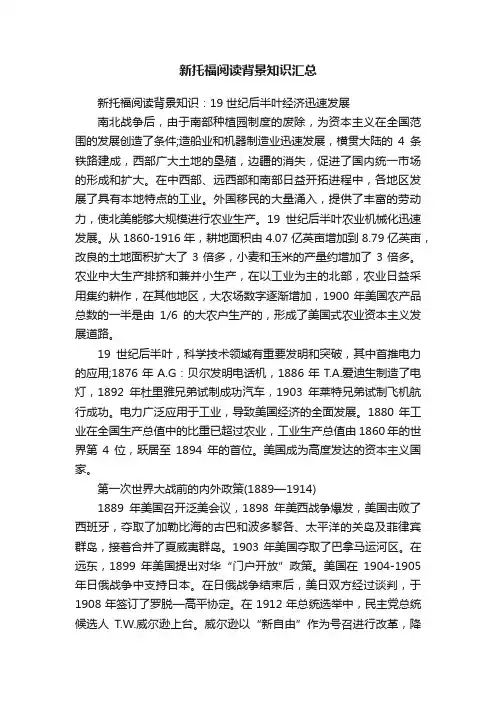
新托福阅读背景知识汇总新托福阅读背景知识:19世纪后半叶经济迅速发展南北战争后,由于南部种植园制度的废除,为资本主义在全国范围的发展创造了条件;造船业和机器制造业迅速发展,横贯大陆的4条铁路建成,西部广大土地的垦殖,边疆的消失,促进了国内统一市场的形成和扩大。
在中西部、远西部和南部日益开拓进程中,各地区发展了具有本地特点的工业。
外国移民的大量涌入,提供了丰富的劳动力,使北美能够大规模进行农业生产。
19世纪后半叶农业机械化迅速发展。
从1860-1916年,耕地面积由4.07亿英亩增加到8.79亿英亩,改良的土地面积扩大了3倍多,小麦和玉米的产量约增加了3倍多。
农业中大生产排挤和兼并小生产,在以工业为主的北部,农业日益采用集约耕作,在其他地区,大农场数字逐渐增加,1900年美国农产品总数的一半是由1/6的大农户生产的,形成了美国式农业资本主义发展道路。
19世纪后半叶,科学技术领域有重要发明和突破,其中首推电力的应用;1876年A.G:贝尔发明电话机,1886年T.A.爱迪生制造了电灯,1892年杜里雅兄弟试制成功汽车,1903年莱特兄弟试制飞机航行成功。
电力广泛应用于工业,导致美国经济的全面发展。
1880年工业在全国生产总值中的比重已超过农业,工业生产总值由1860年的世界第4位,跃居至1894年的首位。
美国成为高度发达的资本主义国家。
第一次世界大战前的内外政策(1889—1914)1889年美国召开泛美会议,1898年美西战争爆发,美国击败了西班牙,夺取了加勒比海的古巴和波多黎各、太平洋的关岛及菲律宾群岛,接着合并了夏威夷群岛。
1903年美国夺取了巴拿马运河区。
在远东,1899年美国提出对华“门户开放”政策。
美国在1904-1905年日俄战争中支持日本。
在日俄战争结束后,美日双方经过谈判,于1908年签订了罗脱—高平协定。
在1912年总统选举中,民主党总统候选人T.W.威尔逊上台。
威尔逊以“新自由”作为号召进行改革,降低关税,建立联邦储备银行制度,通过克莱顿反托拉斯法(1914),征收累进所得税。
1关于美国的历史The continent's first inhabitants walked into North America across what is now the Bering Strait from Asia. For the next 20,000 years these pioneering settlers were essentially left alone to develop distinct and dynamic cultures. In the modern US, their descendants include the Pueblo people in what is now New Mexico; Apache in Texas; Navajo in Arizona, Colorado and Utah; Hopi in Arizona; Crow in Montana; Cherokee in North Carolina; and Mohawk and Iroquois in New York State.The Norwegian explorer Leif Eriksson was the first European to reach North America, some 500 years before a disoriented Columbus accidentally discovered 'Indians' in Hispaniola (now the Dominican Republic and Haiti) in 1492. By the mid-1550s, much of the Americas had been poked and prodded by a parade of explorers from Spain, Portugal, England and France.The first colonies attracted immigrants looking to get rich quickly and return home, but they were soon followed by migrants whose primary goal was to colonize. The Spanish founded the first permanent European settlement in St Augustine, Florida, in 1565; the French moved in on Maine in 1602, and Jamestown, Virginia, became the first British settlement in 1607. The first Africans arrived as 'indentured(合同的,契约的)laborers' with the Brits a year prior to English Puritan pilgrims' escape of religious persecution(迫害). The pilgrims founded a colony at Plymouth Rock, Massachusetts, in 1620 and signed the famous Mayflower Compact - a declaration ofself-government that would later be echoed in the Declaration of Independence and the US Constitution. British attempts to assert authority in its 13 North American colonies led to the French and Indian War (1757-63). The British were victorious but were left with a nasty war debt, which they tried to recoup(赔偿,付还)by imposing new taxes. The rallying cry 'no taxation without representation' united the colonies, who ceremoniously dumped caffeinated cargo overboard during the Boston Tea Party. Besieged British general Cornwallis surrendered to American commander George Washington five years later at Yorktown, Virginia, in 1781. In the 19th century, America's mantra was 'Manifest Destiny.' A combination of land purchases, diplomacy and outright wars of conquest had by 1850 given the US roughly its present shape. In 1803, Napoleon dumped the entire Great Plains for a pittance(微薄收入), and Spain chipped in with Florida in 1819. The Battle of the Alamo during the 1835 Texan Revolution paved the way for Texan independence from Mexico, and the war with Mexico (1846-48) secured most of the southwest, including California.The systematic annihilation(消灭,歼灭)of the buffalo hunted by the Plains Indians, encroachment(侵犯)on their lands, and treaties not worth the paper they were written on led to Native Americans being herded into reservations, deprived of both their livelihoods and their spiritual connection to their land. Nineteenth-century immigration drastically altered the cultural landscape as settlers of predominantly British stock were joined by Central Europeans and Chinese, many attracted by the 1849 gold rush in California. The South remained firmly committed to an agrarian life heavily reliant on African American slave labor. Tensions were on the rise when abolitionist Abraham Lincoln was elected president in 1860. The South seceded from (脱离)the Union, and the Civil War, by far the bloodiest war in America's history, began thefollowing year. The North prevailed(胜利)in 1865, freed the slaves and introduced universal adult male suffrage(选举权). Lincoln's vision for reconstruction, however, died with his assassination. America's trouncing of the Spaniards in 1898 marked the USA's ascendancy as a superpower and woke the country out of its isolationist slumber.The US still did its best not to get its feet dirty in WWI's trenches, but finally capitulated(停止抵抗,有条件投降)in 1917, sending over a million troops to help sort out the pesky(讨厌的,棘手的)Germans. Postwar celebrations were cut short by Prohibition in 1920, which banned alcohol in the country. The 1929 stock-market crash signaled the start of the Great Depression and eventually brought about Franklin Roosevelt's New Deal, which sought to lift the country back to prosperity. After the Japanese dropped in uninvited on Pearl Harbor in 1941, the US played a major role in defeating the Axis powers. Atomic bombs dropped on Hiroshima and Nagasaki in 1945 not only ended the war with Japan, but ushered in the nuclear age. The end of WWII segued into the Cold War - a period of great domestic prosperity and a surface uniformity belied by paranoia and betrayal. Politicians like Senator Joe McCarthy took advantage of the climate to fan anticommunist flames, while the USSR and USA stockpiled nuclear weapons and fought wars by proxy in Korea, Africa and Southeast Asia. Tensions between the two countries reached their peak in 1962 during the Cuban Missile Crisis.The 1960s was a decade of profound social change, thanks largely to the Civil Rights movement, Vietnam War protests and the discovery of sex, drugs and rock & roll. The Civil Rights movement gained momentum in 1955 with a bus boycott in Montgomery, Alabama. As a nonviolent mass protest movement, it aimed at breaking down segregation and regaining the vote for disfranchised Southern blacks. The movement peaked in 1963 with Martin Luther King Jr's 'I have a dream speech' in Washington, DC, and the passage of the landmark 1964 Civil Rights Act and 1965 Voting Rights Act. Meanwhile, America's youth were rejecting the conformity of the previous decade, growing their hair long and smoking lots of dope. 'Tune in, turn on, drop out' was the mantra of a generation who protested heavily (and not disinterestedly) against the war in Vietnam. Assassinations of prominent political leaders - John and Robert Kennedy, Malcolm X and Martin Luther King Jr - took a little gloss off the party, and the American troops mired in Vietnam took off the rest. NASA's moon landing in 1969 did little to restore national pride. In 1974 Richard Nixon became the first US president to resign from office, due to his involvement in the cover-up of the Watergate burglaries, bringing American patriotism to a new low.The 1970s and '80s were a period of technological advancement and declining industrialism. Self image took a battering at the hands of Iranian Ayatollah Khomeni. A conservative backlash, symbolized by the election and popular two-term presidency of actor Ronald Reagan, sought to put some backbone in the country. The US then concentrated on bullying its poor neighbors in Central America and the Caribbean, meddling in the affairs of El Salvador, Nicaragua, Panama and Grenada. The collapse of the Soviet Bloc's 'Evil Empire' in 1991 left the US as the world's sole superpower, and the Gulf War in 1992 gave George Bush the opportunity to lead a coalition supposedly representing a 'new world order' into battle against Iraq. Domestic matters, such as health reform, gun ownership, drugs, racial tension, gay rights, balancing the budget, the tenacious Whitewater scandal and the Monica Lewinsky 'Fornigate' affair tended to overshadow international concerns during the Clinton administration. In a bid to kickstart its then-ailing economy, the USA signed NAFTA, a free-trade agreement with Canada and Mexico, in 1993, invaded Haiti in its role of upholder of democracy in 1994, committed thousands of troops topeacekeeping operations in Bosnia in 1995, hosted the Olympics in 1996 and enjoyed, over the past few years, the fruits of a bull market on Wall St. The 2000 presidential election made history by being the most highly contested race in the nation's history.The Democratic candidate, Al Gore, secured the majority of the popular vote but lost the election when all of Florida's electoral college votes went to George W Bush, who was ahead of Gore in that state by only 500 votes. Demands for recounts, a ruling by the Florida Supreme Court in favor of partial recounts, and a handful of lawsuits generated by both parties were brought to a halt when the US Supreme Court split along party lines and ruled that all recounts should cease. After five tumultuous weeks, Bush was declared the winner. The early part of Bush's presidency saw the US face international tension, with renewed violence in the Middle East, a spy-plane standoff with China and nearly global disapproval of US foreign policy with regard to the environment. On the domestic front, a considerably weakened economy provided challenges for national policymakers. Whether the US can continue to hold onto its dominant position on the world stage and rejuvenate its economy remains to be seen.2英属北美殖民地的建立(1607--1733)北美洲原始居民为印第安人。
TOEFL阅读背景知识为了让大家更好的准备托福考试,给大家整理新托福阅读背景知识,下面就和大家分享,来欣赏一下吧。
新托福阅读背景知识:地球的旋转时间变短地球的旋转时间变短We have been talking about some of the effects that the human beings had on the earth. One you may not be aware of is that we actually begin to change the length of the day. In the other way to say, one day is the amount of time the earth needs to spin completely around an axis, the imaginary line around the center of the earth, from the north to the south. And of course there are a lot of physical causes th at can affect the speed of the earth’s rotation, but there was only one that is direct result of the human activity. Since 1950, human beings have built about ten thousand artificial reservoirs all over the world. These reservoirs have redistributed tremendous amount of the earth water. When they are used to be in the area near the equator, the imaginary line surround the middle of the earth, it’s now the reservoirs in the areas of differentlatitudes. The latitude matters because, well, thinking the earth and axis, the equator contains the areas on the earth that are the farthest away from axis. So water has been redistributed from the equator regions, then wherever the water is, to it’s close to the earth axis. It’s like when ice skaters perform spins when those skaters put their arms enclose to their bodies, they spin faster. So the earth is spinning faster because the reservoirs have redistributed the water close to its axis. And because the earth was spinning faster, since 1950 the length of day has decreased by about 8 millionths of second. I know that doesn’t sound like much but significant in that this is the first time that human beings ever had measurable affect on the earth’s motion.新托福阅读背景知识:潮汐发电潮汐发电凡在海边上生活过的人都知道,海水时进时退,海面时涨时落。
托福阅读背景知识汇总托福考试中,阅读想要做的又快有准确,不仅需要提升英语阅读能力,还要掌握阅读背景知识。
下面就和大家分享托福阅读背景知识知多少,来欣赏一下吧。
托福阅读背景知识知多少阅读背景知识汇总一.考古学(archaeology)题材1.文化(cultural )考古学形态(physical)考古学(多见)2.化石(fossil )化石构成。
化石比原物更沉重(矿物质环境)化石形成原因。
坚硬物质,迅速掩埋。
化石与动物的进化关系。
3.人的左右手使用工具。
证据:敲击的划痕;手柄的形状。
牙齿上的划痕。
大脑左右半球的大小差别;趾骨的粗细差别。
作画时人像的方向4.古代陶瓷的考古。
Clay,model,wheel (转盘),glaze,kiln5.古代文字的考古。
二.印第安题材1.白令海峡移民理论2.印第安文化3.印第安宗教观4.印第安建筑业:大、先进。
5.印第安手工业:好。
6.社会组织结构:严密、分工细、凝聚力强。
7.农业先进:A. irrigation; B. maize,squash,bean,pea。
三.动植物题材(必考)1.植物学题材(不多见)地衣、苔、真菌、蘑菇最常见。
树冠上方生物。
植物在生态平衡中的作用。
2.动物学题材(90%以上)考普通动物为多。
最近常考鸟类、蚂蚁、动物智能与灭绝(联系天文学与冰河理论)。
考动物进化(evolution)。
考动物的分类(classification)。
phyla(单数phylum)—门class—纲order—目family—科genus—属species—种carnivore/predator—食肉动物herbivore—食草动物omnivore—杂食动物动物的生活习性最为多见。
群居(social animal)动物的习性蚂蚁:社会组织结构—等级制(caste):交流方式—信息素—气味;生活****;外来物种的有害性。
蜜蜂:群居个性;“8”字舞;蜜蜂智能;防御;天敌—大黄蜂。
目录1. 关于美国的历史 (2)2,英属北美殖民地的建立(1607--1733) (5)3 独立的民族主权国家的建成(1781-1814) (6)4 南北战争及重建时期(1861-1877) (8)5第一次世界大战前的内外政策(1889—1914) (9)6 第二次世界大战期间的美国 (10)7 The American Revolution (11)8 The Civil War (14)9 Native Americans (16)10 Native American languages (17)11 Native Americans in the popular imagination (18)12 George Washington (1732-99) (19)13 美国历史大事年表 (21)14 Maya (25)15 玛雅象形文字之谜 (28)16霓虹灯 (29)17美国大都市洛杉矶 (30)18 •友爱之城费城 (31)19议坛之城芝加哥 (33)20大苹果纽约 (35)21牛仔城达拉斯 (37)22 美国为什么迁都华盛顿 (39)23 美国文学简史 (40)24 民族文学的诞生 (41)25 “婆罗门” (42)26 乡土文学与马克.吐温 (43)27 •黑人文学 (44)28 •迷惘的一代 (45)29 •“南方文艺复兴” (46)30 第二次世界大战后 (47)31 “黑色幽默” (48)32 黑人文学 (49)33 杰克.伦敦生平 (50)34 The Sea-Wolf/海狼 (54)35 心理需求层次 (55)36 石化林的一点背景知识 (57)37 初识芭蕾 (58)38脚尖的艺术 (59)39 地球的旋转时间变短 (62)40 潮汐发电 (63)41,42 海水发电 (63)43 蜘蛛丝军事用途 (65)44 艺术流派 (65)45 polymer gels一种聚合凝胶 (67)46 Backgrounds of Washington (67)47 鹦鹉螺(中文版) (70)48 About nautilus and king nautilus (71)49 科氏力(coriolis force) (72)50 What is p53 ? (73)51纳米材料及其应用 (74)52 睡与梦( dream and sleep) (76)53 梦的背景知识 (79)54 the code of Hammurabi (81)55 流星与流星雨 (83)56 anthill 的背景资料 (85)57 Gas Hydrate (86)58 Lava (87)59 A Brief History of the Guitar (87)60 jazz的完整历史 (89)1. 关于美国的历史The continent's first inhabitants walked into North America across what is now the Bering Strait from Asia. For the next 20,000 years these pioneering settlers were essentially left alone to develop distinct and dynamic cultures. In the modern US, their descendants include the Pueblo people in what is now New Mexico; Apache in Texas; Navajo in Arizona, Colorado and Utah; Hopi in Arizona; Crow in Montana; Cherokee in North Carolina; and Mohawk and Iroquois in New York State.The Norwegian explorer Leif Eriksson was the first European to reach North America, some 500 years before a disoriented Columbus accidentally discovered 'Indians' in Hispaniola (now the Dominican Republic and Haiti) in 1492. By the mid-1550s, much of the Americas had been poked and prodded by a parade of explorers from Spain, Portugal, England and France.The first colonies attracted immigrants looking to get rich quickly and return home, but they were soon followed by migrants whose primary goal was to colonize. The Spanish founded the first permanent European settlement in St Augustine, Florida, in 1565; the French moved in on Maine in 1602, and Jamestown, Virginia, became the first British settlement in 1607. The first Africans arrived as 'indentured(合同的,契约的)laborers' with the Brits a year prior to English Puritan pilgrims' escape of religious persecution(迫害). The pilgrims founded a colony at Plymouth Rock, Massachusetts, in 1620 and signed the famous Mayflower Compact - a declaration ofself-government that would later be echoed in the Declaration of Independence and the US Constitution. British attempts to assert authority in its 13 North American colonies led to the French and Indian War (1757-63). The British were victorious but were left with a nasty war debt, which they tried to recoup(赔偿,付还)by imposing new taxes. The rallying cry 'no taxation without representation' united the colonies, who ceremoniously dumped caffeinated cargo overboard during the Boston Tea Party. Besieged British general Cornwallis surrendered to American commander George Washington five years later at Yorktown, Virginia, in 1781. In the 19th century, America's mantra was 'Manifest Destiny.' A combination of land purchases, diplomacy and outright wars of conquest had by 1850 given the US roughly its present shape. In 1803, Napoleon dumped the entire Great Plains for a pittance(微薄收入), and Spain chipped in with Florida in 1819. The Battle of the Alamo during the 1835 Texan Revolution paved the way for Texan independence from Mexico, and the war with Mexico (1846-48) secured most of the southwest, including California.The systematic annihilation(消灭,歼灭)of the buffalo hunted by the Plains Indians, encroachment(侵犯)on their lands, and treaties not worth the paper they were written on led to Native Americans being herded into reservations, deprived of both their livelihoods and their spiritual connection to their land. Nineteenth-century immigration drastically altered the cultural landscape as settlers of predominantly British stock were joined by Central Europeans and Chinese, many attracted by the 1849 gold rush in California. The South remained firmly committed to an agrarian life heavily reliant on African American slave labor. Tensions were on the rise when abolitionist Abraham Lincoln was elected president in 1860. The South seceded from (脱离)the Union, and the Civil War, by far the bloodiest war in America's history, began the following year. The North prevailed(胜利)in 1865, freed the slaves and introduced universaladult male suffrage(选举权). Lincoln's vision for reconstruction, however, died with his assassination. America's trouncing of the Spaniards in 1898 marked the USA's ascendancy as a superpower and woke the country out of its isolationist slumber.The US still did its best not to get its feet dirty in WWI's trenches, but finally capitulated(停止抵抗,有条件投降)in 1917, sending over a million troops to help sort out the pesky(讨厌的,棘手的)Germans. Postwar celebrations were cut short by Prohibition in 1920, which banned alcohol in the country. The 1929 stock-market crash signaled the start of the Great Depression and eventually brought about Franklin Roosevelt's New Deal, which sought to lift the country back to prosperity. After the Japanese dropped in uninvited on Pearl Harbor in 1941, the US played a major role in defeating the Axis powers. Atomic bombs dropped on Hiroshima and Nagasaki in 1945 not only ended the war with Japan, but ushered in the nuclear age. The end of WWII segued into the Cold War - a period of great domestic prosperity and a surface uniformity belied by paranoia and betrayal. Politicians like Senator Joe McCarthy took advantage of the climate to fan anticommunist flames, while the USSR and USA stockpiled nuclear weapons and fought wars by proxy in Korea, Africa and Southeast Asia. Tensions between the two countries reached their peak in 1962 during the Cuban Missile Crisis.The 1960s was a decade of profound social change, thanks largely to the Civil Rights movement, Vietnam War protests and the discovery of sex, drugs and rock & roll. The Civil Rights movement gained momentum in 1955 with a bus boycott in Montgomery, Alabama. As a nonviolent mass protest movement, it aimed at breaking down segregation and regaining the vote for disfranchised Southern blacks. The movement peaked in 1963 with Martin Luther King Jr's 'I have a dream speech' in Washington, DC, and the passage of the landmark 1964 Civil Rights Act and 1965 Voting Rights Act. Meanwhile, America's youth were rejecting the conformity of the previous decade, growing their hair long and smoking lots of dope. 'Tune in, turn on, drop out' was the mantra of a generation who protested heavily (and not disinterestedly) against the war in Vietnam. Assassinations of prominent political leaders - John and Robert Kennedy, Malcolm X and Martin Luther King Jr - took a little gloss off the party, and the American troops mired in Vietnam took off the rest. NASA's moon landing in 1969 did little to restore national pride. In 1974 Richard Nixon became the first US president to resign from office, due to his involvement in the cover-up of the Watergate burglaries, bringing American patriotism to a new low.The 1970s and '80s were a period of technological advancement and declining industrialism. Self image took a battering at the hands of Iranian Ayatollah Khomeni. A conservative backlash, symbolized by the election and popular two-term presidency of actor Ronald Reagan, sought to put some backbone in the country. The US then concentrated on bullying its poor neighbors in Central America and the Caribbean, meddling in the affairs of El Salvador, Nicaragua, Panama and Grenada. The collapse of the Soviet Bloc's 'Evil Empire' in 1991 left the US as the world's sole superpower, and the Gulf War in 1992 gave George Bush the opportunity to lead a coalition supposedly representing a 'new world order' into battle against Iraq. Domestic matters, such as health reform, gun ownership, drugs, racial tension, gay rights, balancing the budget, the tenacious Whitewater scandal and the Monica Lewinsky 'Fornigate' affair tended to overshadow international concerns during the Clinton administration. In a bid to kickstart its then-ailing economy, the USA signed NAFTA, a free-trade agreement with Canada and Mexico, in 1993, invaded Haiti in its role of upholder of democracy in 1994, committed thousands of troops to peacekeeping operations in Bosnia in 1995, hosted the Olympics in 1996 and enjoyed, over thepast few years, the fruits of a bull market on Wall St. The 2000 presidential election made history by being the most highly contested race in the nation's history.The Democratic candidate, Al Gore, secured the majority of the popular vote but lost the election when all of Florida's electoral college votes went to George W Bush, who was ahead of Gore in that state by only 500 votes. Demands for recounts, a ruling by the Florida Supreme Court in favor of partial recounts, and a handful of lawsuits generated by both parties were brought to a halt when the US Supreme Court split along party lines and ruled that all recounts should cease. After five tumultuous weeks, Bush was declared the winner. The early part of Bush's presidency saw the US face international tension, with renewed violence in the Middle East, a spy-plane standoff with China and nearly global disapproval of US foreign policy with regard to the environment. On the domestic front, a considerably weakened economy provided challenges for national policymakers. Whether the US can continue to hold onto its dominant position on the world stage and rejuvenate its economy remains to be seen.2,英属北美殖民地的建立(1607--1733)北美洲原始居民为印第安人。